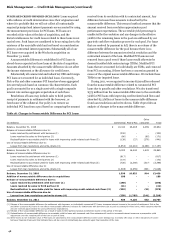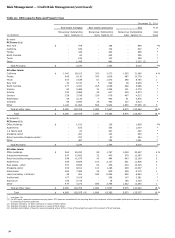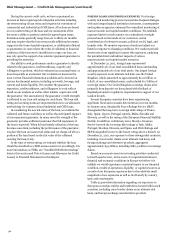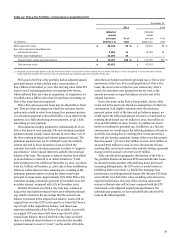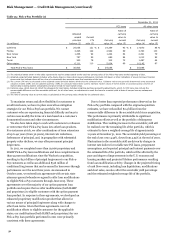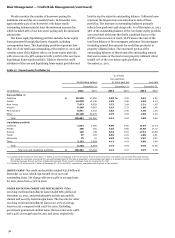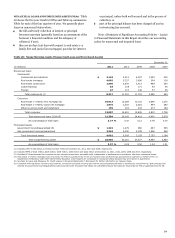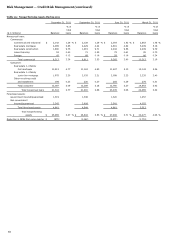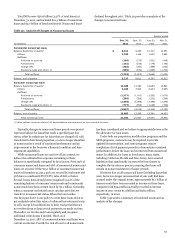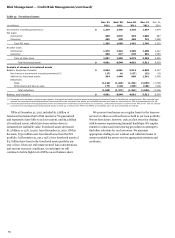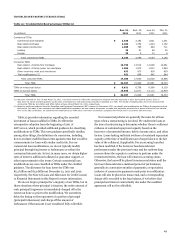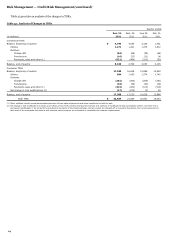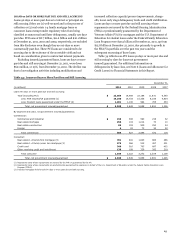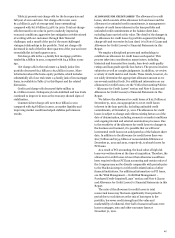Wells Fargo 2011 Annual Report Download - page 60
Download and view the complete annual report
Please find page 60 of the 2011 Wells Fargo annual report below. You can navigate through the pages in the report by either clicking on the pages listed below, or by using the keyword search tool below to find specific information within the annual report.
Risk Management — Credit Risk Management (continued)
We also monitor the number of borrowers paying the
minimum amount due on a monthly basis. In December 2011,
approximately 94% of our borrowers with home equity
outstanding balances paid at least the minimum amount due,
which included 46% of our borrowers paying only the minimum
amount due.
The home equity liquidating portfolio includes home equity
loans generated through third party channels, including
correspondent loans. This liquidating portfolio represents less
than 1% of our total loans outstanding at December 31, 2011, and
contains some of the highest risk in our home equity portfolio,
with a loss rate of 9.36% compared with 3.02% for the core (non-
liquidating) home equity portfolio. Table 27 shows the credit
attributes of the core and liquidating home equity portfolios and
lists the top five states by outstanding balance. California loans
represent the largest state concentration in each of these
portfolios. The decrease in outstanding balances primarily
reflects loan paydowns and charge-offs. As of December 31, 2011,
36% of the outstanding balance of the core home equity portfolio
was associated with loans that had a combined loan to value
(CLTV) ratio in excess of 100%. CLTV means the ratio of the
total loan balance of first mortgages and junior lien mortgages
(including unused line amounts for credit line products) to
property collateral value. The unsecured portion of the
outstanding balances of these loans (the outstanding amount
that was in excess of the most recent property collateral value)
totaled 17% of the core home equity portfolio at
December 31, 2011.
Table 27: Home Equity Portfolios (1)
% of loans
two payments
Outstanding balance
or more past due
Loss rate
December 31,
December 31,
December 31,
(in millions)
2011
2010
2011
2010
2011
2010
Core portfolio (2)
California
$
25,555
27,850
3.03
%
3.30
3.61
4.92
Florida
10,870
12,036
4.99
5.46
4.99
6.13
New Jersey
7,973
8,629
3.73
3.44
2.31
1.95
Virginia
5,248
5,667
2.15
2.33
1.68
1.86
Pennsylvania
5,071
5,432
2.82
2.48
1.40
1.24
Other
46,165
50,976
2.79
2.83
2.66
3.04
Total
100,882
110,590
3.13
3.24
3.02
3.62
Liquidating portfolio
California
2,024
2,555
5.50
6.66
12.64
15.19
Florida
265
330
7.02
8.85
11.56
13.72
Arizona
116
149
6.64
6.91
17.51
20.89
Texas
97
125
0.93
2.02
2.89
2.81
Minnesota
75
91
2.83
5.39
7.67
9.57
Other
3,133
3,654
4.13
4.53
6.88
7.48
Total
5,710
6,904
4.73
5.54
9.36
10.90
Total core and liquidating portfolios
$
106,592
117,494
3.22
3.37
3.37
4.08
(1)
Consists predominantly of real estate 1-4 family junior lien mortgages and first and junior lines of credit secured by real estate, but excludes PCI loans because
their losses are generally covered by PCI accounting adjustment at the date of acquisition, and excludes real estate 1
-4 family first lien open-ended line reverse
mortgages because they do not have scheduled payments. These reverse mortgage loans are insured by the FHA.
(2)
Includes $1.5 billion and $1.7 billion at December 31, 2011 and 2010, respectively, associated with the Pick-a-Pay portfolio.
CREDIT CARDS
Our credit card portfolio totaled $22.8 billion at
December 31, 2011, which represented 3% of our total
outstanding loans. Net charge-offs were 5.58% of average loans
for 2011, down from 9.74% in 2010.
OTHER REVOLVING CREDIT AND INSTALLMENT
Other
revolving credit and installment loans totaled $86.5 billion at
December 31, 2011, and predominantly include automobile,
student and security-based margin loans. The loss rate for other
revolving credit and installment loans was 1.22% of average
loans for 2011 compared with 1.94% for 2010. Excluding
government guaranteed student loans, the loss rates were 1.46%
and 2.43% of average loans for 2011 and 2010, respectively.
58


